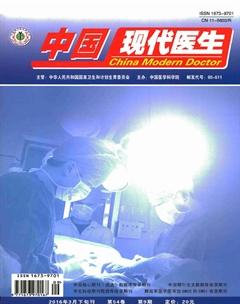上皮间质转化在宫颈癌侵袭和转移中的作用研究
巴彩霞 郭佳 白雪峰


[摘要] 目的 探讨上皮间质转化(epithelial-mesenchymal transition,EMT)对宫颈癌侵袭和转移的影响。 方法 对33例宫颈浸润癌组织和23例宫颈原位癌组织(对照组)采用免疫组化方法进行EMT标志物的检测。 结果 ①免疫组化检测显示56例宫颈癌组织中,发生浸润及淋巴结转移后,E-cadherin/β-catenin复合物的表达显著低于原位癌组织(P<0.05),而Vimentin的表达显著高于原位癌组织(P<0.05)。②浸润性宫颈癌组织中Fibronectin及N-cadherin表达与组织学分级密切相关。③FN的表达与癌组织的浸润深度相关。 结论 宫颈癌的侵袭转移过程中存在着EMT现象,可以为宫颈癌的靶向治疗提供理论依据。
[关键词] EMT;宫颈癌;转移;免疫组化
[中图分类号] R737.3 [文献标识码] A [文章编号] 1673-9701(2016)09-0005-04
[Abstract] Objective To investigate the effect of EMT on the invasion and metastasis of cervical cancer. Methods Immunohistochemistry was use to detectded the expression of markers of EMT in 33 cases of invasive cervical cancer and 23 cases of cervical carcinoma in situ (control group). Results ①Expression of E-cadherin/β-catenin in invasive carcinoma and lymph node metastasis group was lower than carcinoma in situ(P<0.05), and expression of Vimentin in invasive carcinoma and lymph node metastasis group was higher than carcinoma in situ(P<0.05). ②The expression of FN and N-cadherin had relations with histological grade in Invasive cervical cancer. ③The expression of FN had relations with invasive depth of carcinoma. Conclusion Invasion and metastasis of cervical cancer exists phenomenon of EMT, which may provide a theoretic basis for the targeted treatment of cervical cancer.
[Key words] EMT; Cervical cancer; Metastasis; Immunohistochemistry
上皮细胞向间质细胞转化(epithelial-mesenchymal transition,EMT)是哺乳动物胚胎发育过程中的生理现象,但不适当的EMT使上皮性癌细胞获得迁移侵袭的能力,影响着多种恶性肿瘤的进展[1,2]。目前宫颈癌细胞如何获得入侵周围组织的能力依然未知,但普遍认为EMT发挥了重要的作用。一些分子表型表达情况与EMT过程密切相关,被认为是EMT的标志物[3,4]。本研究检测EMT相关标志物上皮性钙黏附蛋白(E-cadherin)、β-链蛋白(β-catenin)、神经性钙粘蛋白(N-cadherin)、纤连蛋白(Fibronectin,FN)及波形蛋白(Vimentin)在宫颈癌中的表达情况,探讨EMT在宫颈癌侵袭转移中的作用,为宫颈癌的治疗和预后预测提供新的有价值的实验依据,现报道如下。
1 材料与方法
1.1 材料来源
收集我院2013年6月~2015年6月经病理检查明确诊断的宫颈鳞癌标本56例(原位癌23例,浸润癌33例),患者年龄31~67岁,平均48岁。宫颈鳞癌患者在术前均未接受任何放疗、化疗和生物治疗,并有完整的临床资料、病理诊断及随访资料。
1.2 方法
手术标本经中性甲醛固定,石蜡包埋,4.5 μm厚切片,HE和免疫组化染色。免疫组化采用高压MaxVision法。标记一抗包括E-cadherin、β-catenin、N-cadherin、Fibronectin及Vimentin。所用免疫组化相关试剂购自福州迈新生物技术开发有限公司。
1.3 免疫组织化学结果判定
采用双盲法阅片。①E-cadherin和β-catenin免疫组化阳性物质呈棕褐色,主要定位于细胞膜。>90%癌细胞细胞膜阳性为高表达,<10%癌细胞细胞膜阳性为无表达。②N-cadherin免疫组化阳性物质主要定位于细胞膜,Vimentin及Fibronectin免疫组化阳性物质主要定位于细胞质。N-cadherin及Vimentin的判断标准参照Nakajima S等的方法:≥20%癌细胞阳性为阳性表达;<20%癌细胞阳性为阴性表达。Fibronectin正常时癌细胞不表达,发生EMT时癌细胞胞浆表达。
1.4 统计学处理
应用SPSS15.0统计学软件进行数据分析,组间阳性率比较采用χ2检验,以α=0.05为检验标准,P<0.05为差异有统计学意义。
2 结果
2.1 E-cadherin/β-catenin复合物及Vimentin在宫颈癌中的表达
56例宫颈癌中,23例原位癌E-cadherin/β-catenin复合物表达率为37.80%(图1、2),20例浸润癌无淋巴转移E-cadherin/β-catenin复合物表达率为10.00%,13例浸润癌有淋巴转移患者E-cadherin/β-catenin复合物表达率为7.69%(表1)。组间差异有统计学意义(χ2=6.79,P<0.05)。发生浸润及淋巴结转移后,E-cadherin/β-catenin表达下调。此外,在淋巴转移中存在个别病例E-cadherin和β-catenin表达均缺失,而在无淋巴转移时并未发现二者同时不表达的情况。
浸润癌淋巴结转移组Vimentin阳性率为53.80%(图3),浸润癌无淋巴转移Vimentin阳性率为40.00%,而原位癌Vimentin阳性表达率仅为13.00%,差异有统计学意义(χ2=7.23,P<0.05),说明宫颈癌在发生浸润及淋巴结转移时,Vimentin的表达上调(表1)。在原位癌和无淋巴转移时,个别病例Vimentin存在阳性表达,但仅为弱阳性或局灶阳性。
2.2 FN及N-cadherin与宫颈浸润癌临床病理特征的关系
在宫颈浸润癌中,FN及N-cadherin表达与组织学分级密切相关(图4、5)(χ2=6.75、8.85,P<0.05),此外FN的表达与癌组织的浸润深度相关(χ2=5.94,P<0.05)(表2);而五种EMT标志物与宫颈癌的早期浸润及局部侵袭(颈管累犯)无明显相关性(P>0.05)。
3 讨论
肿瘤细胞发生EMT后,侵袭能力明显增强[1]。体外实验证实许多肿瘤细胞系发生了部分或完全的EMT,瘤细胞失去了上皮细胞大部分的特征,而一些间叶来源细胞表型重新表达或高表达。相比于上皮细胞,间质细胞不存在完整的细胞层结构,呈纤维样改变,但具有很强的移动性和可塑性,能够离开原发灶,入侵和转移至其他组织及器官。
E-cadherin属于Ⅰ型钙粘着蛋白,只表达于上皮细胞[5]。β-catenin是细胞粘附连接的组成成分,其与受体蛋白α-catenin相连后绑定于E-cadherin胞内区域,形成E-cadherin-β-catenin-α-catenin复合体,与肌动蛋白细胞骨架连接。因此,E-cadherin/β-catenin复合物是构建和维持细胞间联系的核心力量。其缺失将导致细胞间粘附力下降而促使癌细胞的侵袭能力提升[6-9],转染E-cadherin cDNA到浸润性癌细胞里可抑制其转移能力。我们发现宫颈癌发生浸润及淋巴结转移后,E-cadherin/β-catenin复合物表达下调,并且有个别病例E-cadherin和β-catenin表达同时缺失。Vimentin是一种重要的Ⅲ型中间丝蛋白,广泛存在于间质细胞及中胚层来源的细胞中,与癌细胞的粘附侵袭相关[8,10,11]。发生淋巴结转移的宫颈癌,vimentin表达上调,阳性率达53.80%。这些细胞表型的变化意味着细胞间粘附力下降,极性丢失。
EMT与E-cadherin表达下调相伴随的是产生N-cadherin,称为钙粘蛋白的转换,其主要表达于间叶细胞[12-15],与多种肿瘤的恶性程度、浸润及转移密切相关。我们发现N-cadherin与宫颈浸润癌的病理组织学分级正相关,Ⅲ级时阳性率最高。此外,另一种标志物FN属多粘附基质蛋白,可作为肿瘤组织分化程度低、侵袭性强、易于复发的判断指标。FN的表达与宫颈癌的浸润深度及组织学分级正相关,癌组织浸润越深,细胞分化越差时,FN阳性表达越高。
此外,实验发现宫颈原位癌早期浸润和浸润癌局部侵袭颈管与五种EMT标志物没有显著的相关性,我们认为可能是在宫颈癌早期和局部的发展中,没有大量触发EMT的因子,癌细胞没有发生明显的EMT过程,宫颈癌EMT在何时何处发生,受哪些因子激发和调控将是今后研究的一个有意义的方向。
目前,宫颈癌细胞EMT的机制成为研究的热点,一些关键转录因子被发现及报道。锌指转录因子Snail家族在宫颈癌EMT发生的过程中起着重要的作用[16,17]。Snail能够抑制紧密连接蛋白、闭合蛋白及血栓调节蛋白的表达,更是重要的E-cadherin转录抑制因子[17],并和宫颈癌淋巴结转移密切相关[16]。E和结合锌指蛋白(Zeb1/2)可下调E-cadherin的表达,Zeb1可诱导vimentin表达上调[18]。其表达与宫颈癌的侵袭性、盆腔淋巴结转移、临床分期呈正相关[19]。另已发现Twist是一种在EMT过程中居于重要地位的基本螺旋-环-螺旋(basichelix-loop-hlix,bHLH)转录因子,抑制E-cadherin的表达[17]。Twist1的高表达预示宫颈癌的预后及放化疗抵抗[20];Twist2的表达则可预测宫颈鳞状细胞癌的转移潜力[17]。
此外,Hsu等[21]发现第三型钾氯协同转运蛋白(KCC-3)参与宫颈癌EMT的发生,过度表达KCC-3的癌细胞呈现出EMT发生时的特征。阻断KCC-3后癌细胞在细胞连接间E-cadherin and β-catenin的生成大量增加。KCC-3可抑制E-cadherin基因的转录和加速β-catenin蛋白的降解。在宫颈癌手术标本中,肿瘤组织KKC-3表达水平与癌细胞增殖范围密切相关。表皮生长因子(EGFR)也可促使宫颈癌细胞发生相似的改变[22]。正常宫颈上皮细胞极少表达EGFR,EMT中的细胞形态和分子标志不受EGFR刺激的影响。临床手术标本证实宫颈癌细胞EGFR过度表达与E-cadherin/β-catenin低表达伴随发生。
综上所述,宫颈癌的侵袭转移过程中存在着EMT现象。癌细胞发生EMT后,细胞表型发生变化,侵袭转移能力增强。然而,宫颈癌EMT体外实验面临着诸多限制,几乎没有正常的癌细胞能够经历完整的EMT过程,究其原因可能是EMT对培养环境非常敏感。在活体内,EMT的分子机制仍然没有得到全面完整的分析。但是随着实验条件的完善,EMT过程及发生机制的研究将逐渐深入,最终能够为宫颈癌靶向药物的研制及临床治疗提供可靠的依据。
[参考文献]
[1] Jeff H. Tsai,Jing Yang,Genes Dev. Epithelial-mesenchymal plasticity in carcinoma metastasis[J]. Bibliteca De Recursos,2013,27(20):2192-2206.
[2] Chui MH. Insights into cancer metastasis from a clinicopathologic perspective:Epithelial-mesenchymal transition is not a necessary step[J]. Int J Cancer,2013,132(7):1487-1495.
[3] Zhau HE,Odero-Marah V,Lue HW,et al. Epithelial tomesen-chymal transition(EMT) in human prostate cancer: Lessons learned from ARCaP model[J]. Clin Exp Metastasis,2008,25(6):601-610.
[4] David Sarrio,Socorro Mara Rodriguez-Pinilla,David Hardisson,et al. Epithelial-mesenchymal transition in breast cancer relates to the basal-like phenotype[J]. Cancer Res,2008,68(4):989-997.
[5] Peinado H,Portillo F,Cano A. Transcriptional regulation of cadherins during development and carcinogenesis[J]. Int J Dev Biol,2004,48(5-6):365-375.
[6] Mark A Eckert,Thinzar M Lwin,Andrew T Chang,et al. Twist1-induced invadopodia formation promotes tumor metastasis[J]. Cancer Cell,2011,19(3): 372-386.
[7] Gjerdrum C,Tiron C,Hoiby T,et al. Axl is an essential epithelial-to-mesenchymal transition-induced regulator of breast cancer metastasis and patient survival[J]. Proc Natl Acad Sci USA,2010,107(3):1124-1129.
[8] Lei Huang,A-Man Xu,Sha Liu,et al. Cancer-associated fibroblasts in digestive tumors[J]. World J Gastroenterol,2014,20(47):17804-17818.
[9] Chiang CH,Hou MF,Hung WC. Up-regulation of miR-182 by beta-catenin in breast cancer increases tumorigenicity and invasiveness by targeting the matrix metalloproteinase inhibitor RECK[J]. Biochim Biophys Acta,2013, 1830(4):3067-3076.
[10] Kokkino MI,Wafai R,Wong MK,et al. Vimentin and epithelial-mesenchymal transition in human breast cancer-observations in vitro andin vivo[J]. Cells Tissues Organs,2007,185(1-3):191-203.
[11] Cong H,Yao RY,Sun ZQ,et al. DNA hypermethylation of the vimentin gene inversely correlates with vimentin expression in intestinal-and diffuse-type gastric cancer[J].Oncol Lett,2016,11(1):842-848.
[12] Gao MQ,Kim BG,Kang S,et al. Stromal fibroblasts from the interface zone of human breast carcinomas induce an epithelial-mesenchymal transition-like state in breast cancer cells in vitro[J]. J Cell Sci,2010,123(Pt20):3507-3514.
[13] De Wever O,Westbroek W,Verloes A,et al. Critical role of N-cadherin in myofibroblast invasion and migration in vitro stimulated by colon-cancer-cell-derived TGF-beta or wounding[J]. J Cell Sci,2004,117(Pt20):4691-4703.
[14] Rybinski B,Franco-Barraza J,Cukierman E. The wound healing,chronic fibrosis,and cancer progression triad[J]. Physiol Genomics,2014,46(7):223-244.
[15] Tiwari N,Gheldof A,Tatari M,et al. EMT as the ultimate survival mechanism of cancer cells[J]. Semin Cancer Biol,2012,22(3):194-207.
[16] Zhao W,Zhou Y,Xu H,et al. H. Snail family proteins in cervical squamous carcinoma:Expression and significance[J]. Clinical and Investigative Medicine,2013,36(4):E223-E233.
[17] Lee MY,Shen MR.Epithelial-mesenchymal transition in cervical carcinoma[J]. American Journal of Translational Research,2012,4(1):1-13.
[18] Qureshi R,Arora H,Rizvi MA. EMT in cervical cancer:its role in tumour progression and response to therapy[J].Cancer Letters,2015,356(2):321-331.
[19] Chen Z,Li S,Huang K,et al. The nuclear protein expression levels of SNAI1 and ZEB1 are involved in the progression and lymph node metastasis of cervical cancer via the epithelial-mesenchymal transition pathway[J]. Human Pathology,2013,44(10):2097-2105.
[20] Zhu K,Chen L,Han X,et al. Short hairpin RNA targeting Twist1 suppresses cell proliferation and improves chemosensitivity to cisplatin in HeLa human cervical cancer cells[J]. Oncology Reports,2012,27(4):1027-1034.
[21] Hsu YM,Chen YF,Chou CY,et al. KCl cotransporter-3 down-regulates E-cadherin/h-catenin complex to promote epithelial-mesenchymal transition[J]. Cancer Res,2007,67(22):11064-11073.
[22] Lee MY,Chou CY,Tang MJ,et al. Epithelial-mesenchymal transition in cervical cancer:Correlation with tumor progression,epidermal growth factor receptor overexpression,and snail up-regulation[J]. Clin Cancer Res,2008, 14(15):4743-4750.
(收稿日期:2016-01-25)

